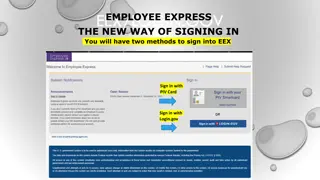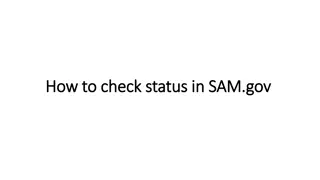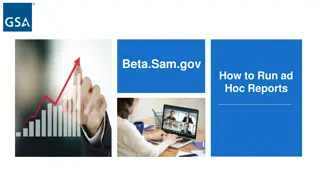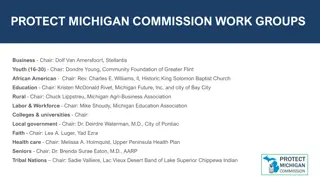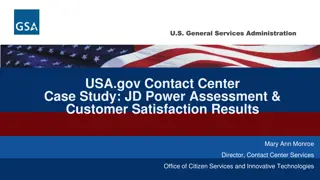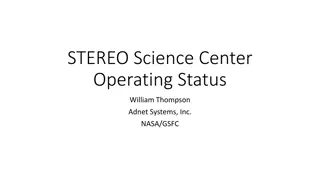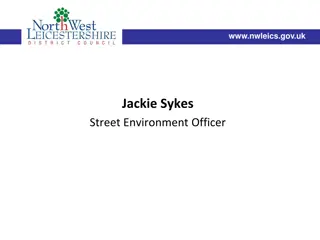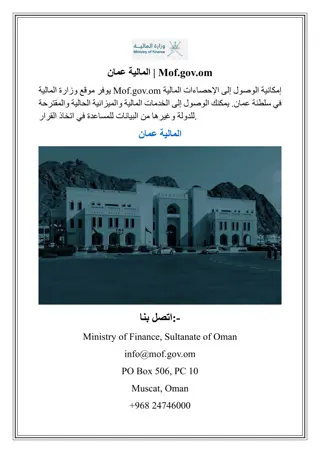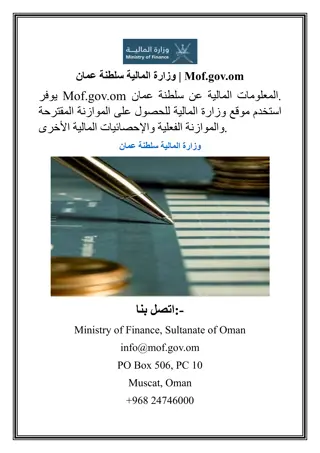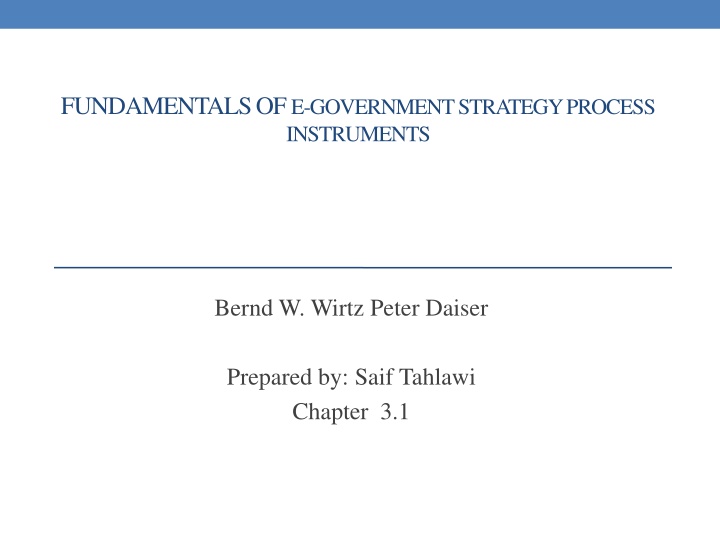
E-Government Value Chains and Systems
Explore the concept of E-Government Value Activity Systems (EVAS) and the value chain in e-government, which aims to deliver improved public services, administrative efficiency, open government capabilities, ethical behavior, trust in government, and social value. Learn about the activities involved in an exemplary e-government value chain and the significance of marketing and user relationship management in the process.
Download Presentation

Please find below an Image/Link to download the presentation.
The content on the website is provided AS IS for your information and personal use only. It may not be sold, licensed, or shared on other websites without obtaining consent from the author. If you encounter any issues during the download, it is possible that the publisher has removed the file from their server.
You are allowed to download the files provided on this website for personal or commercial use, subject to the condition that they are used lawfully. All files are the property of their respective owners.
The content on the website is provided AS IS for your information and personal use only. It may not be sold, licensed, or shared on other websites without obtaining consent from the author.
E N D
Presentation Transcript
FUNDAMENTALS OF E-GOVERNMENT STRATEGY PROCESS INSTRUMENTS Bernd W. Wirtz Peter Daiser Prepared by: Saif Tahlawi Chapter 3.1
E-Government Value Activity System (EVAS) Introduction Value activity systems are based on the concept of the value chain, which describes a set of organizational activities performed to deliver a product or service to the market. The value chain concept was developed in management research and first described by Michael E. Porter. The underlying idea of the value chain is based on a process view of organizations. The effectiveness and efficiency of the associated activities, which are needed for the transformation process, determine the costs and the profit of the organization.
What value is e-government supposed to yield Six, sometimes overlapping, values were found: Improved public services improved administrative efficiency Open Government (OG) capabilities improved ethical behavior and professionalism improved trust and confidence in government improved social value
Exemplary E-Government Value Chain Given an exemplary e-government value chain, its activities may consist of: content and service concept. content and service development. technological distribution. marketing and user relationship management. e-payment. The marketing and user relationship-related step of the value activity is of vital importance.
E-Government Value Activity System (EVAS) E-government is often referred to as a comprehensive approach to elaborate citizen-oriented public services and enhance public administration effectiveness and efficiency. Thus, it is an important element of public management reform programs across the world. From a theoretical perspective, e-government is a technology- enabled part of the government or public sector governance model that allows unattended public stakeholder access to information and services and forms the technological basis for e-democracy.
E-Government Value Activity System (EVAS) Model Model of E-Government Value Activity System (EVAS), which portrays the key value activities that need to be comprehensively planned, organized, steered, and controlled to promote effective e-government within the public administration environment.
E-Government Value Activity System (EVAS) Model (CON) Despite e-government s online character, it is not a completely virtualized system since also procedures and operations behind the software need to be managed. Hence, efficient and goal- oriented e-government requires solid underlying routines, processes, and structures. For this reason, the EVAS model is based on a value activity perspective of public authorities that outlines an e-government system, which is made up of subsystem activities that have specific inputs, transformation operations, and outputs, which involve acquisition or consumption of human, financial, or knowledge resources. Therefore, the better the individual processes are managed, the more efficient the e-government system runs.
E-Government Value Activity System (EVAS) Model (CON) Regarding the EVAS model, we first have to differentiate between: The Information Transaction-Service (ITS) Front Desk, which is the front line part of the public sector organization with a direct client connection E-Service Provision of Information Services and Transactional Services E-User Relationship Management (E-URM),showing an integrated e- government user relationship process The Administration-System-People(ASP) Back Desk, which deals with internal or supporting activities of the public sector organization without a direct client connection.
E-Service Provision (EVAS) Model Information Services offer purely information-based, single-sided services to the user without interaction or participation activities (e.g. Information retrieval concerning service hours of departments). Transaction Services Partial Transactional Services offer services that are only to some extent provided online and thus still contain media breaks (e.g., the user downloads a form to apply for a work visa or completes a tax declaration). Full Transactional Services are offers that are completely virtualized and thus allow the processing of full administrative procedures without involving further media breaks and without having to appear in person, which usually requires a qualified electronic signature or identification (e.g., change of vehicle registration, requesting a current police certificate of good conduct).
The goal of E-URM in an e-government context (EVAS) Model The goal of E-URM in an e-government context is the maintenance of user relations to induce users that have already used a service to use this service again or use a similar service. This process consists of a sequence of phases: awareness, consideration, usage, reconsideration, dissatisfaction, and recovery.
E-URM phases 1. Awareness phase, the user recognizes the availability of the services provided, which suits his needs. Based on this, an initial user contact is established via information and communication technologies (e.g., visiting the website) . 2. Consideration phase, the potential user is presented with the service offerings from the e-government system, which are tailored to the expected user needs 3. Usage phase, the user should select the desired service and start processing. If the user is satisfied with the handling and the outcome, he may reconsider using the e-government service offering. Therefore, the services offered need to be designed in a way that satisfies the needs of the user.
E-URM phases (CON) Dissatisfaction phase: At this point of the interaction, user satisfaction should be checked through user feedback or monitoring systems that support constant evolution of the services provided. Particular user touch points provide users with bundled, customized service offers, leading to an increased overall satisfaction experience. This is important since in addition to economic also user-oriented aspects need to be taken into account in order to achieve a positive value contribution for the online service offering. If only considered under cost-efficiency perspectives, a reference point refers to any source of information that may influence the user in using or not using e-government services. If, for instance, a friend or a colleague has made a dissatisfying experience while using the e-government system, this may influence the intention to use the system, irrespective of the system s actual quality and efficiency. Although these reference points can only be influenced indirectly, their potential user impact needs to be borne in mind. 4.
(EVAS) Model The ASP Back Desk activities 1. The primary challenge of Human Resource Management is recruitment, training, and motivating employees. Since people are a vital source of skills, knowledge, and value, good human resource management can create a sustainable benefit in implementing and running an efficient e- government. 2. Skill and change management are vital aspects to change the current organization and move employees from the status quo to the e-government environment. First, because public administration and management within an e- government setting demand other skills and competencies than past practice Second, because the shift from old paper-based to new electronically- oriented structures and procedures requires a paramount ( ) transformation of the entire organization. Therefore, training and accompanying employees as well as professional change management are key factors for successful e-government.
(EVAS) Model The ASP Back Desk activities 3. IT Infrastructure and Development The support systems that allow to process and manage information and maintain daily operations (infrastructure) The innovation process of developing and integrating new applications and functionalities (development). Since e-government to high degree depends on well working IT systems and innovative solutions, the related activities are cornerstones ( ) of a rewarding e-government system. 4. Information and data security refers to an important aspect of e-government. We would like to emphasize that the actual security of (1) private user data as well as the (2) perceived security of individual user data and (3) network-based information processing are crucial factors that need to be maintained by all means
(EVAS) Model The ASP Back Desk activities(CON) 5. E-file and document management deal with electronic and paper-based administration of files, documents, and records. In this context, especially the e-government-driven conversion from paper-based work to the paperless organization (e.g., introduction of electronic citizen files) causes complex, extensive conversion procedures in the public sector. 6. Controlling, Monitoring, and Reporting activities Constantly required for keeping track of the overall e-government workflow system and for a consistent and sustainable management of the involved ASP Back Desk and ITS Front Desk activities. These activities can be broken down into a strategic and an operative component. Key aspects of the longer-term oriented strategic controlling are planning, information, and early warning purposes The operative monitoring part focuses on target-performance comparisons for result-oriented steering and control of the overall e- government system.
(EVAS) Model The ASP Back Desk activities(CON) 7. E-Procurement ( ) It is the integration of network-based information and communication technology to support operational and strategic activities that are required to supply the necessary inputs that are not self-created by the organization. Its main target is the reduction of procurement cost, which is partly offset by (1) e- procurement system investments and (2) maintenance cost as well as (3) training cost for employees. 8. E-Invoicing ( ) Close the payment gap in otherwise consistent transactions without media-discontinuity and support compliance in all relevant legal requirements. The widespread introduction of an electronic invoice processing system that allows sending and receiving electronic invoices without media breaks shall ensure significant gains in efficiency and make a notable contribution to sustainable economic and increased competitiveness. E-Invoicing forms the basis for the next step in electronic payment, integrated e-payment systems that enable users to pay invoices directly from web applications. However, these fundamental changes in processes and procedures need to be implemented and managed on a strategic as well as an operative level for successful and efficient e-government. For this reason, E-Invoicing is an important, developing activity that requires intensive care




